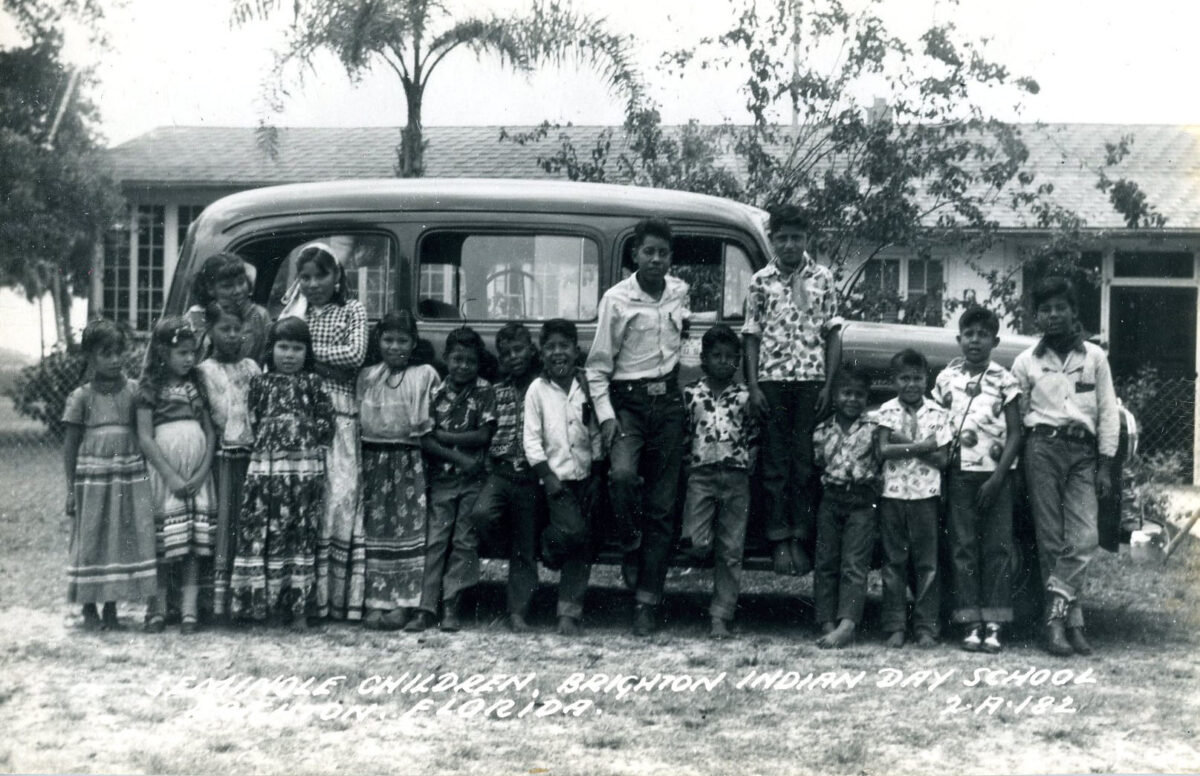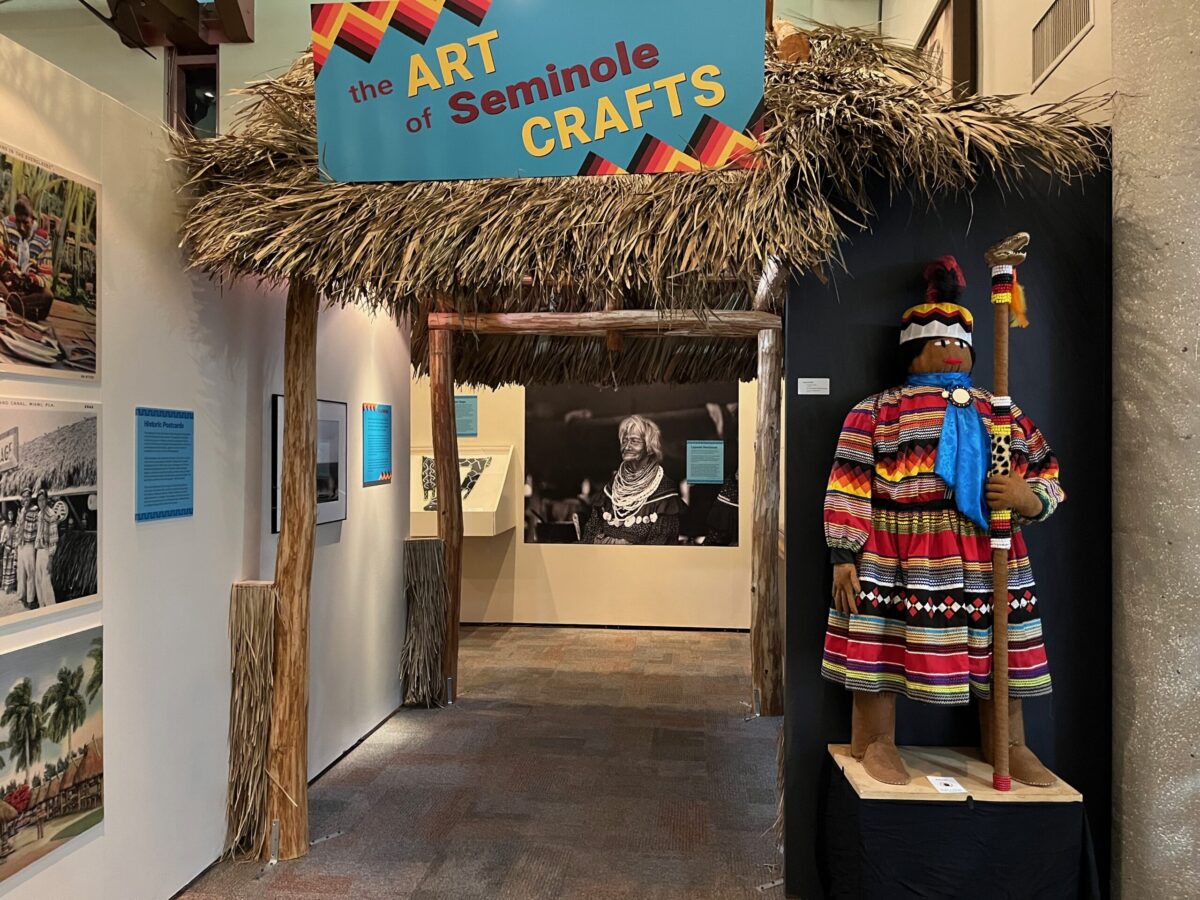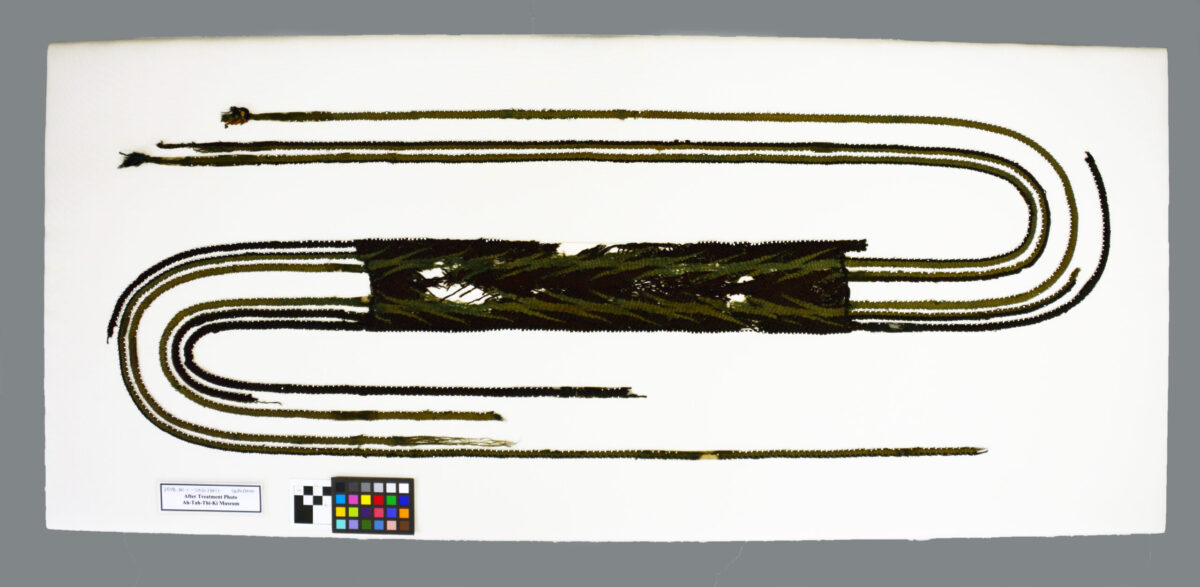
Osceola’s Sash and Legacy
In previous posts, we have touched on the Seminole War period. It was a time of struggle, perseverance, and resistance. In 2018, a sash believed to have been worn by Osceola during his capture made its way home to the Ah-Tah-Thi-Ki Museum and the Seminole Tribe of Florida. This year on November 2nd, the Museum installed it on exhibit to honor Osceola during Native American Heritage Month. This week, join us to learn about Osceola’s sash, and how it returned home!
In our featured image for this week, you can see the recently installed sash. Dark green and black, this finger-woven wool sash features a lightning bolt pattern and delicate beading along the tassels. Dating to the 1800s, it is extremely delicate and fragile. But, despite its delicacy, it carries with it a wealth of power and history. The Ah-Tah-Thi-Ki Museum believes Osceola may have worn this sash at the time of his capture by the United States Army in 1837.
The Seminole Wars
Although historians have broken this time up into three main wars (the First, Second, and Third Seminole Wars), this is not true for Seminoles. Instead, “for the Seminole people there was only one war. They came under armed and organized attack from America in 1812, and the fighting only ended in 1858.” Over these decades, Seminoles were forced deeper and deeper into the Everglades to evade U.S. forces. After the Indian Removal Act was pushed through Congress in 1830, the situation became even more fraught. The Act strengthened U.S. governmental power over all native people, while treaties in the past targeted and displaced specific tribes. With this in place, President Jackson intended to free up fertile land in the southeastern U.S. for farming and development, despite that the land was already occupied. Over 60,000 people were forced from their homes in a 20-year period, with thousands dying.
The 1832 Treaty of Payne’s Landing tried to force Seminoles west of Mississippi to Indian Territory. Many Seminoles resisted, sparking the Second Seminole War, which lasted from 1835-1842. It would be the most costly and longest of the ‘Indian Wars,’ and “for every four Seminoles deported, the US Army killed one Seminole, lost three US Army soldiers, and spent $32,000. In today’s dollars, for every Seminole person shipped west, the government spent the equivalent of $8.5 million.” Seminoles utilized guerilla warfare tactics that the U.S. Army was not prepared for. Seminole fighters such as Cacoochee (Wildcat), Abiaka (Sam Jones), Osceola, and Halpatter (Alligator) would become famous for their staunch resistance and perseverance in the pact of tens of thousands of troops. By the end of the 1840s, Seminoles resistors were the only native people left in their ancestral homes in the Southeast.
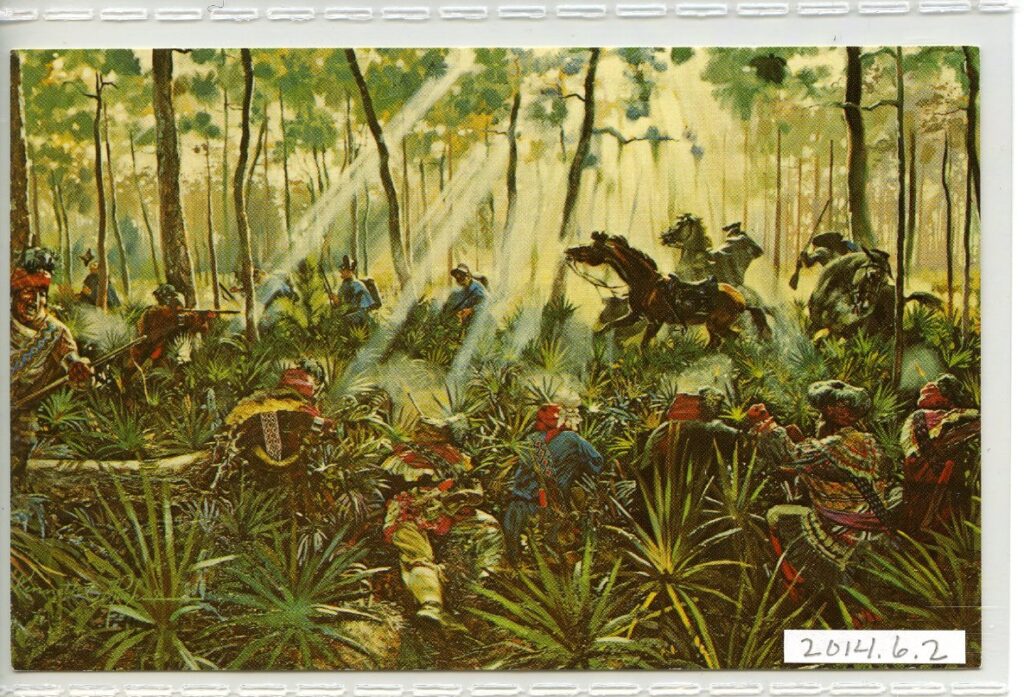
Ken Burns’ Dade Massacre, 2014.16.2, ATTK Museum
‘Chief’ Osceola
One of the most famous Seminole warriors during the Seminole War period, Osceola was known for his fierce opposition to removal, his skill as a speaker, and ability in battle. Born in 1804 as Billy Powell, Osceola had a Creek mother and white father. His family would join the Seminole following the Creek War from 1813-1814. Osceola was not a chief, but is considered an important figure in Seminole history. He often acted as a spokesperson for Abiaka, who was an extremely influential Seminole leader. Osceola was most famous for his calculated and brilliant 1835 attack on Fort King and Wiley Thompson. This attack, along with the Dade Massacre (above), made the Seminole opinion on removal clear. The U.S. Army captured Osceola and Coacoochee under a flag of truce in 1837 in St. Augustine. While Coacoochee would escape, Osceola would die in a South Carolina prison in 1838.
Below, you can see a framed oil painting of Osceola by Robert John Curtis. It is from 1838, and was displayed in Charleston, SC for the first time that same year. Osceola wears traditional clothing with an orange, white, and blue kerchief. He wears a sash over his shoulder that features green diamonds on a black background with white dot accents (indicating white seed beads). Osceola wears another sash with a similar pattern wrapped around his waist. Osceola is also wearing a wrapped turban that features three feathers (one white and two blue), glass drop earrings, and three silver gorgets around his neck. Part of the Ah-Tah-Thi-Ki Museum Collection, this image became incredibly famous after Osceola’s death. While imprisoned, Osceola sat for three portrait artists. Two of them, Robert John Curtis’ and George Catlin’s, you can see in this post.
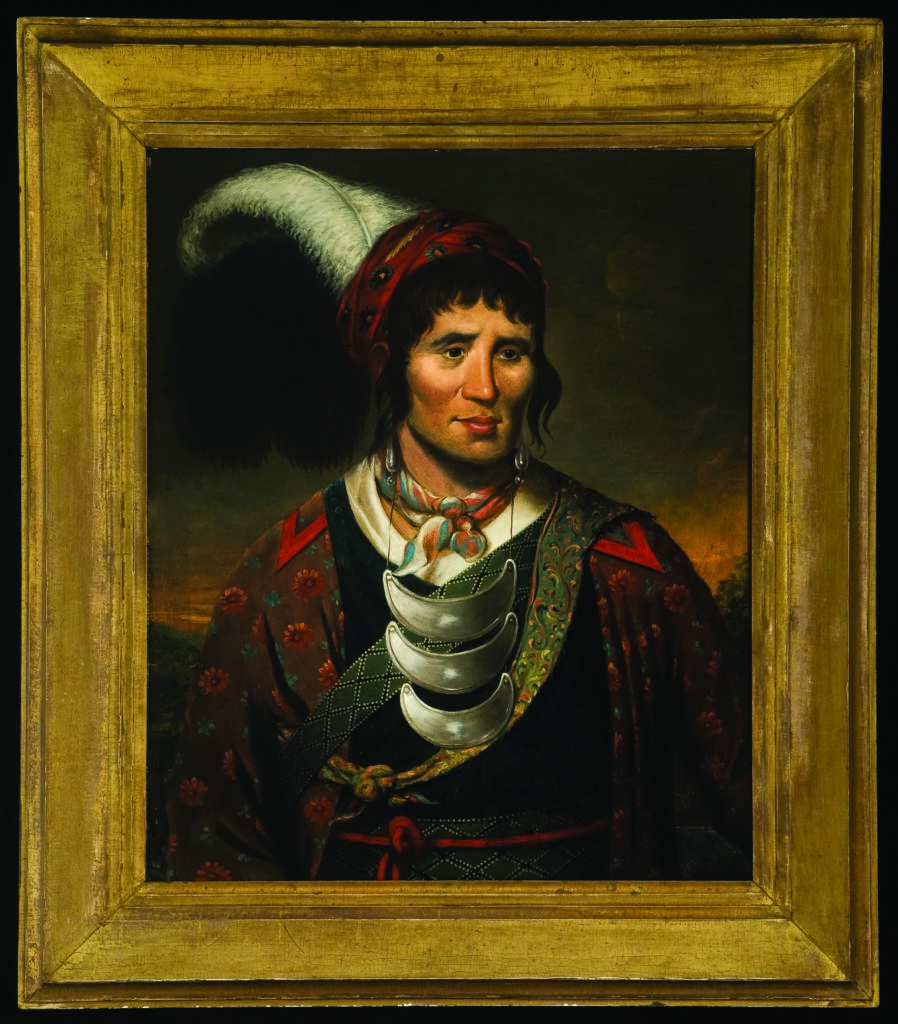
Osceola’s Legacy
Osceola’s impact would be discussed for centuries, despite his relatively short life and notoriety in public discourse. In Osceola’s Legacy, Dr. Patricia Wickman attempts to parse apart the man from the legend, and follows the thread of his history to today. Wickman describes the man plainly, stating “He was not a murderer, acting out of blind, irrational anger. He was, more accurately, an avenger operating out of a cultural code that was radically different from that of his white contemporaries and, tragically, antipathetic to their objectives” (Wickman 28). Beyond his life, though, Osceola would become a symbol that persists to today. A few weeks ago, during the placement of the sash, Ah-Tah-Thi-Ki Museum Director Gordon Wareham touched on Osceola’s importance, stating “his legacy, his story, has moved many to appreciate the Seminole and their legacy, their story, and their narrative” (Ah-Tah-Thi-Ki Seminole Museum Facebook, Video, 11/2/22, 0:20).
Osceola’s image continues to be one that invokes strong feelings and embodies Seminole resistance, power, and memory. Even over 180 years after his death, Osceola remains an important figure in Seminole history and art.
Below, you can see an acrylic painting of Osceola by Noah Billie. Osceola wears an American flag draped over one shoulder. He also has a yellow kerchief tied around his neck and two gorgets visible. A yellow and red turban is on his head, with three large feathers (two black and one white). Billie painted this rendering of Osceola in 1990. The parallels between this portrait and the ones from right before his death are clear. Billie adds another layer, draping the American flag over Osceola’s shoulders and literally dressing him in a mantle of true Native American patriotism and sacrifice. This modern portrait of Osceola touches on how important his legacy is to this day.
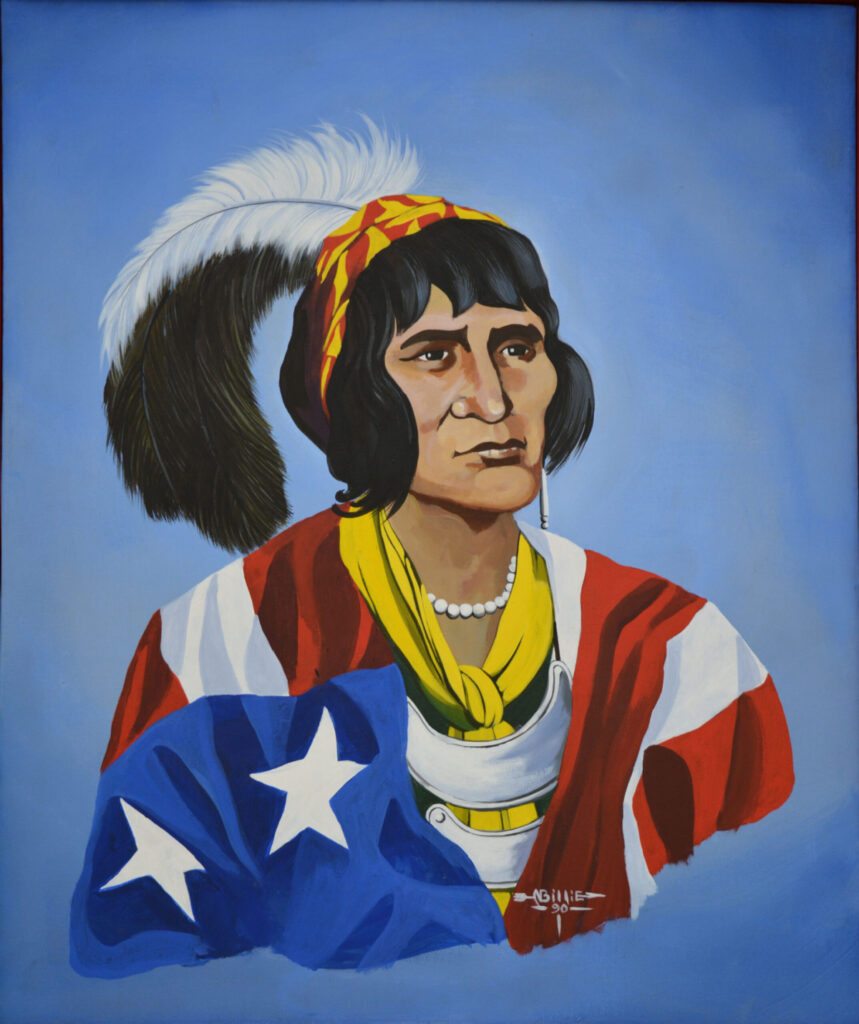
Osceola’s Sash
In 2018, Ah-Tah-Thi-Ki Museum Collections Manager Tara Backhouse received an email from the custodians of the 19th century sash who wanted to return it to the Seminole Tribe of Florida. Joseph and Laralyn Riverwind and friend Melba Checote-Eads discovered an acquaintance had purchased the sash at an estate sale. Understanding its importance, the Riverwinds reached out to the Ah-Tah-Thi-Ki Museum. A 20th century envelope marked “J. Bryan Grimes, Secretary of State, Raleigh, N.C.,” with the handwritten tag “Osceola’s Sash” contained the sash. Additionally, a typed tag identifies it as Osceola’s, and states the sash was “brought to Raleigh by Capt. Francis T. Bryan during the Seminole War.” Backhouse and the Collections staff quickly began research to determine if the tag, style and make of belt, and its connection to Osceola were authentic.
They discovered that Francis T. Bryan was a soldier under Zachary Taylor. The Ah-Tah-Thi-Ki Collections team confirmed J. Brian Grimes Jr. was the Secretary of State of North Carolina in the early 20th century. It also became apparent that the style of belt was one Osceola would have worn. In the portrait below by George Catlin, a sash strikingly like the one received by the Ah-Tah-Thi-Ki Museum in 2018 can be seen around his waist. The finger-woven dark green belt tassels can be seen just to the bottom of the portrait.
As mentioned above, this artist is one of only three who sat with Osceola while imprisoned. This, along with the apparent age and provenance support, lends a strong case to the sash being Osceola’s. In the 2018 blog post linked above, Backhouse notes that while “Historical research is not an exact science…. We at the Museum vow to take steps to preserve this priceless object and to make it accessible to our community.”

Exhibit at the Ah-Tah-Thi-Ki Museum
The Ah-Tah-Thi-Ki Museum has worked hard to fulfill this promise. The Collections staff has spent countless hours researching, caring for, and repairing the fragile sash. Recently, the Ah-Tah-Thi-Ki Museum installed the sash on exhibit for visitors to see in honor of Native American Heritage Month. The Ah-Tah-Thi-Ki Museum unveiled Osceola’s sash before the American Indian Arts Celebration November 4-5, 2022 and was on exhibit for just three weeks until November 21st.
Still looking to learn more about Osceola’s Sash? Check out this previous blog post by Ah-Tah-Thi-Ki Museum Conservator Robin Croskery Howard on how they painstakingly worked to stabilize this delicate object.
Additional Sources
1991 Wickman, Patricia R. Osceola’s Legacy. The University of Alabama Press, Tuscaloosa
Author Bio
Originally from Washington state, Deanna Butler received her BA in Archaeological Sciences from the University of Washington in 2014. Deanna moved to South Florida in 2016. Soon, she began working for the Seminole Tribe of Florida’s Tribal Historic Preservation Office. Deanna was the THPO’s Archaeological Collections Assistant from 2017-2021. While at the THPO, Deanna worked to preserve, support, and process the Tribe’s archaeological collection. She often wrote the popular Artifact of the Month series, and worked on many community and educational outreach programs. She lives in Fort Myers, FL with her husband, son, and dog.


